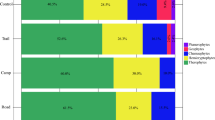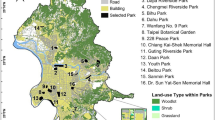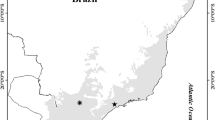Abstract
Urbanization is recognized as a major threat to biodiversity. Within an urbanized area, habitats such as forests and grasslands are often fragmented. Matrixes between fragmented habitats can influence the biodiversity because some of these can act as habitats for some species (hospitable matrixes). The importance of matrixes for biodiversity within the landscape, i.e., the fragmented habitat and matrix, can be influenced by the dispersal ability of the species within the landscape because this can affect the availability of the hospitable matrix. In this study, we evaluated the effects of both local conditions and the surrounding matrix on the species diversity of two taxa with different dispersal abilities, i.e., Carabidae, which has relatively low dispersal ability, and Heteroptera, which has relatively high dispersal ability, in the grassland of urban parks in Tokyo, the most populated region in Japan. The diversity of Carabidae was not strongly influenced by the local habitat size or the amount of surrounding hospitable matrix; however, Heteroptera was strongly influenced by both the local habitat size and amount of surrounding hospitable matrix. Thus, fragmented small habitats might have higher habitat quality depending on the surrounding hospitable matrix for species with relatively high dispersal ability. To promote biodiversity conservation in urban parks, both local habitat management and matrix management are required.


Similar content being viewed by others
Data availability
The datasets generated during and/or analyzed during the current study are available from the corresponding author on reasonable request.
Code availability
Not applicable.
References
Angold PG, Sadler JP, Hill MO et al (2006) Biodiversity in urban habitat patches. Sci Total Environ 360:196–204. https://doi.org/10.1016/j.scitotenv.2005.08.035
Beninde J, Veith M, Hochkirch A (2015) Biodiversity in cities needs space: A meta-analysis of factors determining intra-urban biodiversity variation. Ecol Lett 18:581–592. https://doi.org/10.1111/ele.12427
Camps-Valls G, Campos-Taberner M, Moreno-Martínez Á et al (2021) A unified vegetation index for quantifying the terrestrial biosphere. Sci Adv 7:eabc7447
Cui Q-Y, Gaillard M-J, Lemdahl G et al (2014) Historical land-use and landscape change in southern Sweden and implications for present and future biodiversity. Ecol Evol 4:3555–3570
Dearborn DC, Kark S (2010) Motivaciones para conservar la biodiversidad urbana. Conserv Biol 24:432–440. https://doi.org/10.1111/j.1523-1739.2009.01328.x
Doak DF, Mills LS (1994) A useful role for theory in conservation. Ecology 75:615–626
Ewers RM, Didham RK (2006) Confounding factors in the detection of species responses to habitat fragmentation. Biol Rev 81:117–142
Fenoglio MS, Rossetti MR, Videla M (2020) Negative effects of urbanization on terrestrial arthropod communities: A meta-analysis. Glob Ecol Biogeogr 29:1412–1429. https://doi.org/10.1111/geb.13107
Fischer J, Lindenmayer DB (2007) Landscape modification and habitat fragmentation: a synthesis. Glob Ecol Biogeogr 16:265–280
Grimm NB, Faeth SH, Golubiewski NE et al (2008) Global change and the ecology of cities. Science (80-) 319:756–760. https://doi.org/10.1126/science.1150195
Ito K (1980) Seasonal change of flight ability of Cletus punctiger (Heteroptera: Coreidae). Appl Entomol Zool 15:36–44
Jules ES, Shahani P (2003) A broader ecological context to habitat fragmentation: Why matrix habitat is more important than we thought. J Veg Sci 14:459–464. https://doi.org/10.1111/j.1654-1103.2003.tb02172.x
Kotze DJ, Samways MJ (2001) No general edge effects for invertebrates at Afromontane forest/grassland ecotones. Biodivers Conserv 10:443–466
Kremen C (2015) Reframing the land-sparing/land-sharing debate for biodiversity conservation. Ann N Y Acad Sci 1355:52–76. https://doi.org/10.1111/nyas.12845
Kuefler D, Hudgens B, Haddad NM et al (2010) The conflicting role of matrix habitats as conduits and barriers for dispersal. Ecology 91:944–950
Kuroe M, Yamaguchi N, Kadoya T, Miyashita T (2011) Matrix heterogeneity affects population size of the harvest mice: Bayesian estimation of matrix resistance and model validation. Oikos 120:271–279. https://doi.org/10.1111/j.1600-0706.2010.18697.x
Lindenmayer DB, Fischer J (2007) Tackling the habitat fragmentation panchreston. Trends Ecol Evol 22:127–132. https://doi.org/10.1016/j.tree.2006.11.006
Newbold T, Hudson LN, Hill SLL et al (2015) Global effects of land use on local terrestrial biodiversity. Nature 520:45–50. https://doi.org/10.1038/nature14324
Niemeier S, Müller J, Struck U, Rödel MO (2020) Superfrogs in the city: 150 year impact of urbanization and agriculture on the European Common Frog. Glob Chang Biol 26:6729–6741. https://doi.org/10.1111/gcb.15337
Niemelä J (2001) Carabid beetles (Coleoptera: Carabidae) and habitat fragmentation: A review. Eur J Entomol 98:127–132. https://doi.org/10.14411/eje.2001.023
Nowicki P, Vrabec V, Binzenhöfer B et al (2014) Butterfly dispersal in inhospitable matrix: Rare, risky, but long-distance. Landsc Ecol 29:401–412. https://doi.org/10.1007/s10980-013-9971-0
Öckinger E, Dannestam Å, Smith HG (2009) The importance of fragmentation and habitat quality of urban grasslands for butterfly diversity. Landsc Urban Plan 93:31–37
Ofori BY, Garshong RA, Gbogbo F et al (2018) Urban green area provides refuge for native small mammal biodiversity in a rapidly expanding city in Ghana. Environ Monit Assess 190:1–11
Ohnishi N, Osawa T, Yamamoto T, Uno R (2019) Landscape heterogeneity in landform and land use provides functional resistance to gene flow in continuous Asian black bear populations. Ecol Evol 9:4958–4968
Osawa T, Watanabe K, Ikeda H, Yamamoto S (2014) New approach for evaluating habitat stability using scarce records for both historical and contemporary specimens: a case study using Carabidae specimen records. Entomol Sci 17:425–431. https://doi.org/10.1111/ens.12075
Osawa T, Yamasaki K, Tabuchi K et al (2018) Detecting crucial dispersal pathways using a virtual ecology approach: A case study of the mirid bug Stenotus rubrovittatus. Ambio 47:806–815
Osawa T, Yoshimatsu S-I, Nakatani Y (2020) Specimen-based records and geographic locations of carabid beetles (Coleoptera) collected mainly by Dr. Kazuo Tanaka. Ecol Res. https://doi.org/10.1111/1440-1703.12167
Padilla BJ, Rodewald AD (2015) Avian metapopulation dynamics in a fragmented urbanizing landscape. Urban Ecosyst 18:239–250. https://doi.org/10.1007/s11252-014-0390-z
Pease CG, Zalom FG (2010) Influence of non-crop plants on stink bug (Hemiptera: Pentatomidae) and natural enemy abundance in tomatoes. J Appl Entomol 134:626–636
Peng MH, Hung YC, Liu KL, Neoh KB (2020) Landscape configuration and habitat complexity shape arthropod assemblage in urban parks. Sci Rep 10:1–12. https://doi.org/10.1038/s41598-020-73121-0
Pickett STA, Cadenasso ML, Grove JM et al (2011) Urban ecological systems: Scientific foundations and a decade of progress. J Environ Manage 92:331–362. https://doi.org/10.1016/j.jenvman.2010.08.022
Pryke JS, Samways MJ (2012) Conservation management of complex natural forest and plantation edge effects. Landsc Ecol 27:73–85
Rainio J, Niemelä J (2003) Ground beetles (Coleoptera: Carabidae) as bioindicators. Biodivers Conserv 12:487–506
Ribera I, Dolédec S, Downie IS, Foster GN (2001) Effect of land disturbance and stress on species traits of ground beetle assemblages. Ecology 82:1112–1129
Seto KC, Fragkias M, Güneralp B, Reilly MK (2011) A meta-analysis of global urban land expansion. PLoS ONE 6:e23777
Seto KC, Güneralp B, Hutyra LR (2012) Global forecasts of urban expansion to 2030 and direct impacts on biodiversity and carbon pools. Proc Natl Acad Sci U S A 109:16083–16088. https://doi.org/10.1073/pnas.1211658109
Shibuya S, Kiritani K, Fukuda K (2018) Hind wings in ground beetles (Coleoptera: Carabidae and Brachinidae) – morphology, length, and characteristics of each subfamily. Japanese J Ecol 68:19–41 (in Japanese)
Small EC, Sadler JP, Telfer MG (2002) Carabid beetle assemblages on urban derelict sites in Birmingham, UK. J Insect Conserv 6:233–246
Soga M, Yamaura Y, Koike S, Gaston KJ (2014) Land sharing vs. land sparing: does the compact city reconcile urban development and biodiversity conservation? J Appl Ecol 51:1378–1386
Takatsuki S (2017) Food habits of the raccoon dog at the Tsuda University’s Kodaira Campus, western Tokyo. Humans Nat 28:1–10 ((in Japanese))
Takatsuki S, Yamasaki I, Shirai S (2020) Food habits of raccoon dogs in Ura-Takao, a non-urban area, west of Tokyo. Mamm Sci 60:85–93 (in Japanese)
Takeda A, Yasuda M, Tabuchi K et al (2014) Pattern of immigration of the sorghum plant bug Stenotus rubrovittatus (Hemiptera: Miridae) into paddy fields from a large source habitat. Appl Entomol Zool 49:139–147
Tscharntke T, Tylianakis JM, Rand TA et al (2012) Landscape moderation of biodiversity patterns and processes - eight hypotheses. Biol Rev 87:661–685. https://doi.org/10.1111/j.1469-185X.2011.00216.x
Ueno S, Kurosawa Y, Sato M (1985) The Coleoptera of Japan in Color, Vol. II. Hoikusha, Higashi-Osaka. 514 pp. (in Japanese)
Usher MB, Field JP, Bedford SE (1993) Biogeography and diversity of ground-dwelling arthropods in farm woodlands. Biodivers Lett 54–62
Ushimaru A, Uchida K, Suka T (2018) Grassland biodiversity in Japan: threats, management and conservation. In: Grasslands of the World. CRC press, pp 211–232
Villaseñor NR, Escobar MAH (2019) Cemeteries and biodiversity conservation in cities: how do landscape and patch-level attributes influence bird diversity in urban park cemeteries? Urban Ecosyst 22:1037–1046
Walter HS (2004) The mismeasure of islands: Implications for biogeographical theory and the conservation of nature. J Biogeogr 31:177–197. https://doi.org/10.1046/j.0305-0270.2003.00989.x
Wiegand T, Revilla E, Moloney KA (2005) Effects of habitat loss and fragmentation on population dynamics. Conserv Biol 19:108–121
Yasunaga T, Yamashita I, Takai M, Kawamura M (1993) A field guide of Japanese bugs. Zennokyo, Tokyo
Yasunaga T, Nakatani Y, Takai M, Kawasara T (2001) A field guide of Japanese bugs II. Zennokyo, Tokyo
Acknowledgements
The Tokyo local government provided the city planning GIS data. This study was partially supported by Japan Society for the Promotion of Science KAKENHI grant number 20K06096. Two anonymous reviewers and editor provided many useful suggestions.
Funding
This study was partially supported by JSPS KAKENHI grant number 20K06096.
Author information
Authors and Affiliations
Contributions
SO and TO contributed to the study conception and design. Material preparation, data collection and analysis were performed by SO and TO. SO and NS identified specimens. NT conducted establishing remote sensing products. TO led the manuscript and all authors read and approved the final manuscript.
Corresponding author
Ethics declarations
Ethics approval
Not applicable.
Consent to participate
All patients included in this study gave written informed consent to participate in this research.
Consent for publication
All patients provided written informed consent to publish the data contained within this article.
Conflicts of interests
All authors declare they have no conflicts of interests.
Supplementary Information
Below is the link to the electronic supplementary material.
Rights and permissions
Springer Nature or its licensor (e.g. a society or other partner) holds exclusive rights to this article under a publishing agreement with the author(s) or other rightsholder(s); author self-archiving of the accepted manuscript version of this article is solely governed by the terms of such publishing agreement and applicable law.
About this article
Cite this article
Ohata, S., Osawa, T., Sato, N. et al. Large, concealed islands in the urban sea: Scattered surrounding green space enhances the quality of grassland habitats in urban parks, Tokyo. Urban Ecosyst 26, 641–649 (2023). https://doi.org/10.1007/s11252-022-01311-x
Accepted:
Published:
Issue Date:
DOI: https://doi.org/10.1007/s11252-022-01311-x




